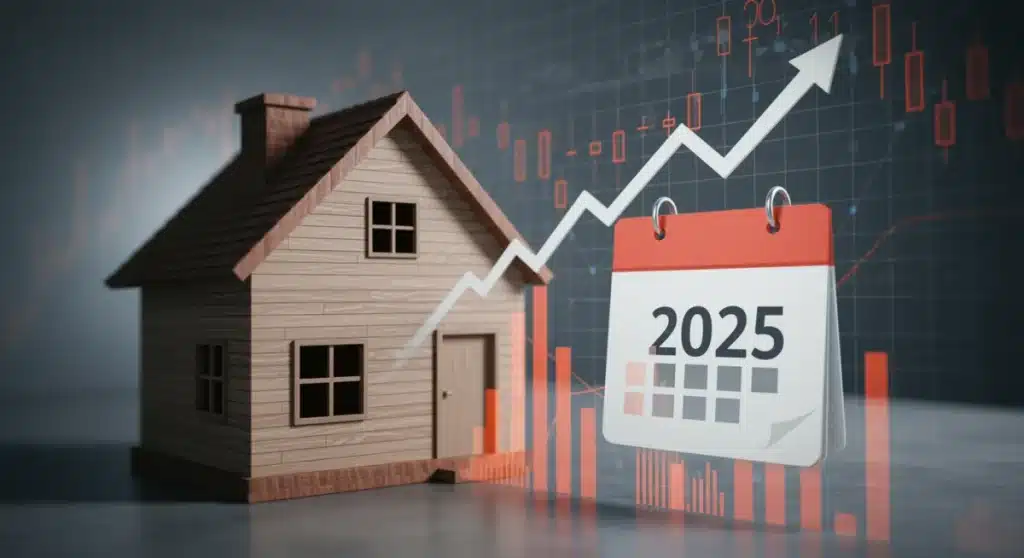Adjustable-Rate Mortgages (ARMs) in 2025: When a 5/1 ARM Makes Financial Sense

Understanding when a 5/1 Adjustable-Rate Mortgage (ARM) makes financial sense in 2025 is critical for homebuyers navigating evolving interest rates and seeking optimal financing in today’s housing market.
In a rapidly changing economic landscape, understanding when a 5/1 Adjustable-Rate Mortgage (ARM) in 2025: When a 5/1 ARM Makes Financial Sense becomes a pivotal question for prospective homeowners and those looking to refinance. Recent market shifts necessitate a closer look at this mortgage product.
Understanding the 5/1 ARM in Today’s Market
The 5/1 Adjustable-Rate Mortgage (ARM) is a type of home loan that features a fixed interest rate for the first five years, after which the rate adjusts annually. This structure can offer lower initial payments compared to a 30-year fixed-rate mortgage, making it an attractive option for certain borrowers. As of early 2025, economic indicators and Federal Reserve policy signals are creating an environment where the initial fixed period of an ARM could provide a significant advantage.
Market analysts, including those at the Mortgage Bankers Association (MBA), project a stabilization, and potentially a slight decrease, in long-term interest rates later in 2025. This forecast directly impacts the appeal of ARMs. Borrowers who secure a 5/1 ARM now could benefit from the initial lower rate, with the expectation that future adjustments might occur in a more favorable rate environment. However, the inherent risk of future rate increases remains a core consideration for any ARM product.
How 5/1 ARMs Function
- Initial Fixed Period: The rate remains constant for the first five years, providing payment predictability.
- Adjustment Period: After five years, the interest rate can change annually based on a pre-selected index plus a margin.
- Caps: ARMs include caps that limit how much the interest rate can increase or decrease in a single adjustment period and over the life of the loan.
- Index and Margin: The adjustable rate is determined by adding a fixed margin to a fluctuating index, such as the Secured Overnight Financing Rate (SOFR).
Current Economic Climate and Rate Projections for 2025
The economic climate in early 2025 is characterized by ongoing efforts to manage inflation and stabilize economic growth. The Federal Reserve’s monetary policy decisions continue to be a primary driver of mortgage rates. While 2024 saw some volatility, recent data suggests a tempering of inflation, leading to expectations of potential rate cuts or at least a plateau by mid-to-late 2025. This outlook is crucial for evaluating the long-term viability of an ARM.
According to a recent report from the National Association of Realtors (NAR), housing demand remains strong, but affordability challenges persist due to elevated rates. This environment makes products like the 5/1 ARM more attractive for borrowers looking to reduce their initial monthly housing costs. The key is to project future financial stability and potential interest rate movements beyond the initial fixed period.
Who Benefits Most from a 5/1 ARM?
A 5/1 ARM is not a one-size-fits-all solution; its suitability largely depends on a borrower’s financial situation, future plans, and risk tolerance. Individuals who anticipate selling their home or significantly increasing their income within the next five to seven years are often ideal candidates. This allows them to capitalize on the lower initial interest rate without being exposed to potential rate increases in the adjustable period.
For example, a young professional expecting a career advancement and a corresponding salary jump within five years might find a 5/1 ARM advantageous. Similarly, someone planning to relocate for work or family reasons within the fixed-rate period could benefit. The lower initial payments free up capital for other investments or savings during those crucial early years of homeownership.
Ideal Borrower Profiles for 5/1 ARMs
- Short-Term Homeowners: Individuals planning to sell their home within 5-7 years.
- Anticipated Income Growth: Borrowers expecting substantial income increases that can absorb potential future rate adjustments.
- Refinancing Intent: Those who plan to refinance before the fixed period ends, perhaps to a fixed-rate mortgage when rates are lower.
- Risk-Tolerant Investors: Buyers comfortable with market fluctuations and who have a robust financial buffer.
Risks and Considerations: Navigating the Adjustable Period
While the allure of lower initial payments is strong, the inherent risks of an ARM cannot be overstated. The primary concern is the potential for interest rates to rise significantly after the fixed period, leading to higher monthly payments. This can strain a borrower’s budget if not properly planned for. It is paramount to understand the adjustment caps and how they limit potential increases.
A recent analysis by S&P Global Ratings highlighted the importance of stress-testing personal finances against worst-case rate scenarios. Borrowers should calculate their maximum possible payment during the adjustable phase to ensure it remains affordable. Furthermore, the economic outlook for 2025, while generally positive for rate stability, still carries uncertainties, making thorough due diligence essential.


Key Risks to Evaluate
- Rate Volatility: Unpredictable increases in the index rate after the fixed period.
- Payment Shock: Sudden, significant increases in monthly mortgage payments.
- Economic Downturns: A recession could impact income while rates rise, creating a challenging scenario.
- Market Conditions: Refinancing might not be an option if rates are high when the fixed period ends.
Strategic Financial Planning with a 5/1 ARM
For a 5/1 ARM to make financial sense, it must be part of a broader, well-thought-out financial strategy. This includes having a clear understanding of your income trajectory, savings capacity, and long-term housing goals. Experts recommend building a substantial emergency fund that can cover potential payment increases, providing a buffer against market fluctuations.
Considering refinancing options before the fixed period expires is another crucial element. If interest rates are favorable at the four-year mark, refinancing into a fixed-rate mortgage could lock in a stable payment for the remainder of the loan term. This proactive approach mitigates much of the risk associated with ARMs. Consulting with a financial advisor specializing in mortgages can provide personalized guidance tailored to individual circumstances and market forecasts.
Comparing 5/1 ARM to Fixed-Rate Mortgages in 2025
The choice between a 5/1 ARM and a fixed-rate mortgage in 2025 depends heavily on current market conditions and individual financial profiles. Fixed-rate mortgages offer stability and predictability, with payments remaining constant throughout the loan term, regardless of market changes. This peace of mind comes at the cost of potentially higher initial interest rates compared to a 5/1 ARM.
In contrast, a 5/1 ARM offers lower initial payments, which can be advantageous for optimizing cash flow in the short term. However, this benefit comes with the uncertainty of future rate adjustments. As of early 2025, the spread between 5/1 ARMs and 30-year fixed rates is a critical factor. When this spread is significant, the ARM becomes more attractive. Conversely, if the spread is narrow, the added risk of an ARM might not justify the minimal initial savings.
Decision Factors for Mortgage Type
- Interest Rate Spread: Compare the difference between current ARM and fixed rates.
- Length of Stay: How long do you plan to live in the home?
- Risk Tolerance: Your comfort level with fluctuating payments.
- Future Income Projections: Anticipated changes in your earning capacity.
- Refinancing Opportunities: Likelihood of securing a better rate before adjustment.
The Future of ARMs in a Dynamic Housing Market
Looking ahead, the role of Adjustable-Rate Mortgages in the housing market is likely to evolve with economic conditions. If interest rates remain volatile or trend downward in the coming years, ARMs could see increased popularity as borrowers seek to capitalize on initial savings. However, regulatory scrutiny and consumer education will remain vital to ensure borrowers fully understand the product’s complexities.
The Consumer Financial Protection Bureau (CFPB) continues to emphasize transparency in mortgage products, urging lenders to clearly disclose all terms and potential payment changes. This focus on consumer protection aims to prevent the missteps seen in previous housing cycles. For 2025, the 5/1 ARM represents a strategic tool for certain buyers, but its effective use hinges on informed decision-making and a clear understanding of both its benefits and inherent risks.
| Key Point | Brief Description |
|---|---|
| Initial Lower Rates | 5/1 ARMs typically offer lower interest rates for the first five years compared to fixed-rate options. |
| Ideal Borrower Profile | Best suited for those planning to sell or refinance within 5-7 years, or expecting significant income growth. |
| Risk of Rate Increases | After the fixed period, rates can adjust annually, potentially leading to higher monthly payments. |
| Strategic Planning | Requires a clear financial strategy, including emergency funds and potential refinancing plans. |
Frequently Asked Questions About 5/1 ARMs in 2025
A 5/1 ARM is a mortgage with a fixed interest rate for the first five years. After this initial period, the interest rate adjusts annually based on a market index plus a margin, subject to specific caps that limit how much the rate can change at each adjustment and over the loan’s lifetime.
A 5/1 ARM makes financial sense for borrowers who plan to sell or refinance their home within the initial five-year fixed period. It’s also suitable for those expecting significant income increases that can comfortably absorb potential future payment adjustments, leveraging lower initial rates.
The primary risk is payment shock, where monthly payments increase significantly after the fixed period due to rising interest rates. Economic downturns could also impact income, making higher payments difficult. It’s crucial to understand rate caps and future market conditions.
5/1 ARMs typically offer lower initial rates and payments but carry future uncertainty. 30-year fixed mortgages provide payment stability and predictability throughout the loan term, though often at a higher initial rate. The best choice depends on individual financial goals and risk tolerance.
Before opting for a 5/1 ARM, build an emergency fund to cover potential payment increases. Plan for a potential refinance before the fixed period ends, especially if rates are favorable. Consult a financial advisor to assess your income trajectory and long-term housing goals.
What Happens Next
As 2025 unfolds, the trajectory of interest rates and broader economic stability will continue to shape the relevance and appeal of 5/1 ARMs. News outlets will closely monitor Federal Reserve announcements and inflation data, which are key determinants of future mortgage market conditions. Borrowers considering an ARM should stay informed on these developments and proactively engage with financial experts to adapt their strategies. The dynamic nature of the housing market demands continuous vigilance and informed decision-making to harness the potential benefits of an ARM while mitigating its inherent risks.





